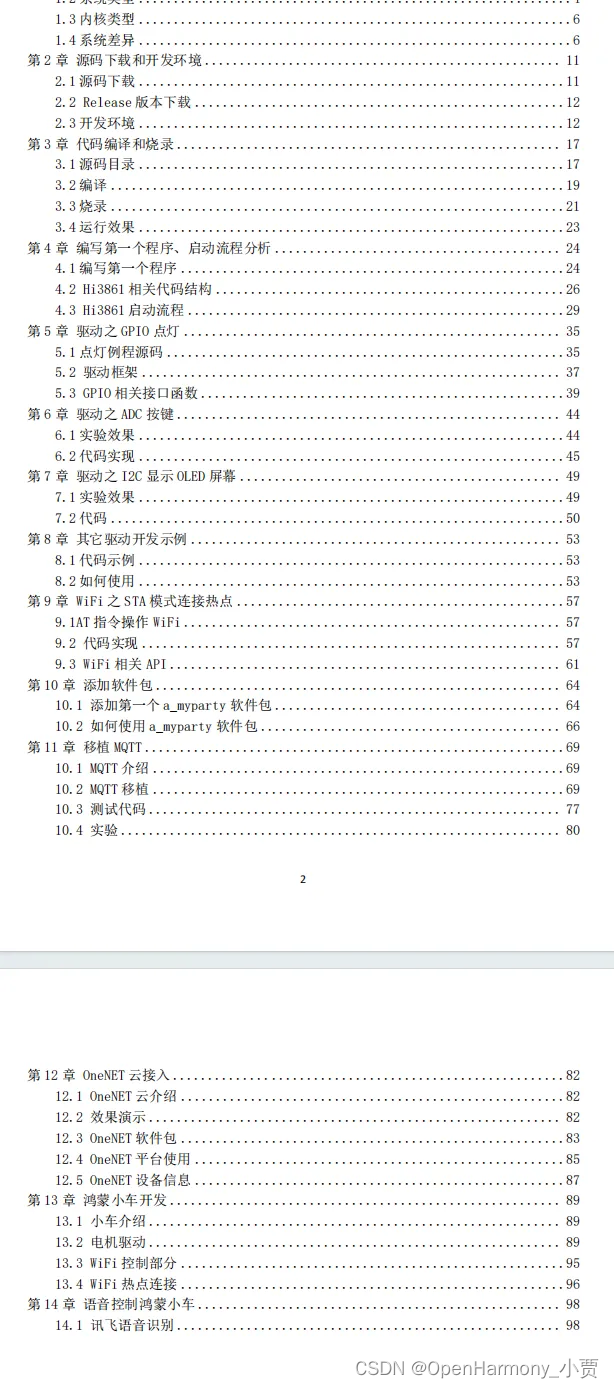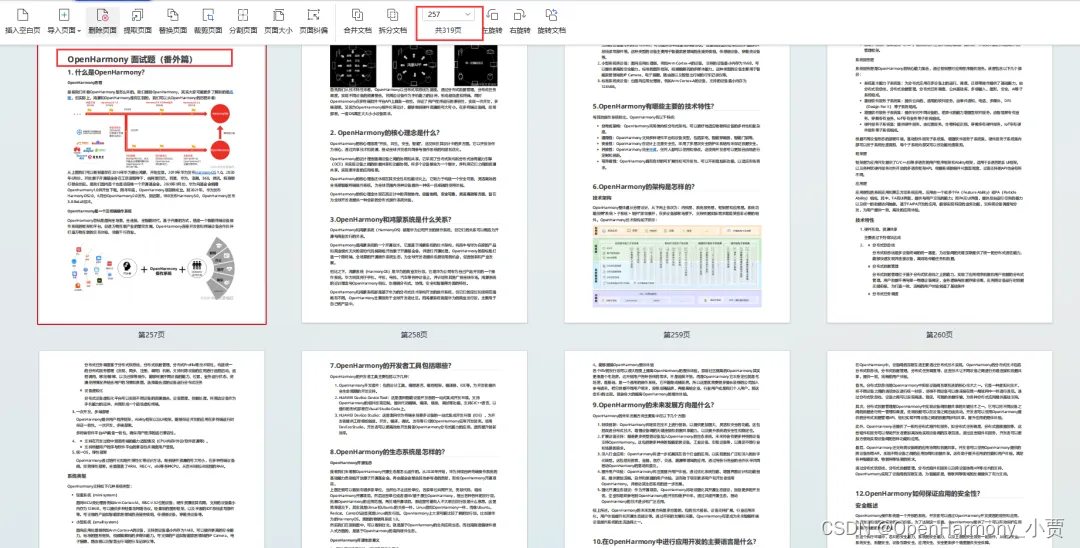发现各个子系统、组件、三方库目录下都添加了bundle.json,了解下该文件的用途、用法并快速记录下。
1、HPM Bundle的基本概念
Bundle是OpenHarmony中一个用来表示分发单元的术语,等同于包,一个Bundle中通常包含以下内容:
- 被分发的二进制文件(二进制类型)
- 被分发的源代码文件(源代码/代码片段类型)
- 编译脚本(发行版类型需要)
- 自身的说明文件
- bundle.json:元数据声明(名称,版本,依赖等)
- LICENSE:许可协议文本
- README.md:自述文件
- CHANGELOG.md:变更日志(可选)
一个Bundle被发布到HPM服务器( https://hpm.harmonyos.com )后,另外一些开发者就可以通过hpm包管理器下载安装使用 。一个Bundle在命名空间内拥有唯一的名称(命名格式为:@scope/name),可以进行独立的版本演进。
一个bundle包通常具有如下代码组织结构:
demo
├── headers # 头文件(样例)
│ └── main.h
└── src # 源代码(样例)
│ └─ main.c
├── bundle.json # 元数据声明文件
└── LICENSE # 许可协议文本
└── Makefile # 编译描述文件(样例)
└── README.md # Bundle的自述文件
2、bundle.json文件格式定义
文件bundle.json一般具有如下格式,对各个属性值的解释见注释部分。因为是json文件,注意下是对象还是数组。对象由花括号{}括起来的逗号分割的成员构成,成员是字符串键和值由逗号分割的键值对组成。数组是由方括号[]括起来的一组值构成。
{
"name": "@ohos/<component_name>", # HPM部件的英文名称, 由@符合、组织名称、部件名称组成。
"description": "component description", # 部件描述
"version": "3.1.0", # 版本号,3.1 应该取的OpenHarmony版本号
"homePage": "https://gitee.com/openharmony", # 部件的主页
"license": "BSD 3-claus", # 部件的版权协议,根据部件license情况填写
"publishAs": "code-segment", # 发布形式,一般为代码片段code-segment
"segment": { # 部件的代码路径
"destPath": "<subsystem>/<component_name>"
},
"dirs": [], # HPM包的目录结构
"scripts": {}, # HPM包定义需要执行的脚本
"component": { # 部件的属性信息
"name": "<component_name>" # 部件的名称,和"@ohos/<component_name>"中的名称应该是一致的。
"subsystem": "xxx subsystem", # 部件所属子系统
"syscap": [ "SystemCapability.<Subsystem>.<Feature>.<Subfeature>" ] # 部件为应用提供的系统能力
"features": [ "<component_name>_<feature>" ] # 部件的特性列表
"adapted_system_type": [ "<system_type>" ] # 部件适用的系统类型:轻量(mini)、小型(small)和标准(standard)
"rom": "xxxKB", # ROM占用
"ram": "xxxKB", # RAM占用
"deps": {
"components": [ # 部件依赖的其他部件
"xxx_component"
],
"third_party": [ # 部件依赖的三方开源软件
"<third_party_software_name>"
]
},
"build": { # 部件编译构建配置,可以多个
"sub_component": [ "//<domain>/<subsystem>/<component_name>/<sub_component>" ], # 部件的子部件编译入口
"inner_kits": [ # 部件内部接口,可以多个
{
"header": { # 内部头文件信息
"header_base": "<domain>/<subsystem>/<component_name>/interface/innerkits/<sub_component>", # 内部头文件目录
"header_files": [ "xxx.h" ] # 头文件名称
},
"name": "<domain>/<subsystem>/<component_name>/interface/innerkits/<sub_component>" # 内部接口名称
}
]
"test": [ "<domain>/<subsystem>/<component_name>/test" ] # 部件测试用例编译入口,可以多个测试套入口
}
}
}
3、bundle.json示例
查看bundle.json文件的分布,在各个子系统,三方库下都存在。在开发板移植时,是不需要的。如果需要开发HPM包,是需要编写bundle.json文件的。可以随便打开一个查看具体的示例。
~/openharmony$ find ./ -name bundle.json
./ark/js_runtime/bundle.json
......
./base/account/os_account/bundle.json
......
./build/common/bundle.json
./developtools/bytrace_standard/bundle.json
......
./drivers/adapter/bundle.json
./drivers/peripheral/audio/bundle.json
......
./foundation/aafwk/standard/bundle.json
......
./kernel/linux/build/bundle.json
./kernel/liteos_a/bundle.json
./kernel/liteos_m/bundle.json
./test/xts/acts/bundle.json
......
./third_party/abseil-cpp/bundle.json
......
./utils/native/bundle.json
......
看下分布式软总线的示例openharmony\foundation\communication\dsoftbus\bundle.json。⑴处定义HPM包的名字,和⑶处的部件名称一样,都为dsoftbus_standard。⑵处的脚本,类似npm包一样,在执行hpm install时,来安装这个hpm包。⑷处设置该hpm包属于哪个子系统,已经适配的子系统类型,包含的特性等。⑸设置依赖的其他部件和三方库。⑹处设置该hpm包的编译构建信息。⑺处设置该hpm包的测试套信息。
{
⑴ "name": "@openharmony/dsoftbus_standard",
"version": "3.1.0",
"description": "dsoftbus_standard",
"publishAs": "code-segment",
"scripts": {
⑵ "install": "DEST_PATH=${DEP_BUNDLE_BASE}/foundation/communication/dsoftbus && mkdir -p $DEST_PATH && cp -r ./* $DEST_PATH"
},
"author": {},
"repository": "",
"license": "Apache License 2.0",
"component": {
⑶ "name": "dsoftbus_standard",
⑷ "subsystem": "communication",
"adapted_system_type": [
"mini",
"small",
"standard"
],
"features": [
"dsoftbus_standard_feature_conn_p2p",
"dsoftbus_standard_feature_disc_ble",
"dsoftbus_standard_feature_conn_br",
"dsoftbus_standard_feature_conn_ble"
],
"rom": "967KB",
"ram": "28MB",
⑸ "deps": {
"components": [
"libhilog",
"libipc_single",
"libwifi_sdk",
"libsystem_ability_fwk",
"libsyspara",
"samgr_proxy",
"utils_base"
],
"third_party": [
"libcoap",
"libmbedtls",
"bounds_checking_function"
]
},
⑹ "build": {
"sub_component": [
"//foundation/communication/dsoftbus/core:softbus_server",
"//foundation/communication/dsoftbus/sdk:softbus_client",
"//foundation/communication/dsoftbus/core/frame/standard/sa_profile:softbus_sa_profile",
"//foundation/communication/dsoftbus/tools:tool"
],
"inner_kits": [
{
"name": "//foundation/communication/dsoftbus/sdk:softbus_client",
"header": {
"header_files": [
"bus_center/softbus_bus_center.h",
"common/softbus_common.h",
"discovery/discovery_service.h",
"transport/session.h"
],
"header_base": "//foundation/communication/dsoftbus/interfaces/kits"
}
}
],
⑺ "test": [
"//foundation/communication/dsoftbus/tests/adapter/unittest:unittest",
"//foundation/communication/dsoftbus/tests/sdk/discovery/unittest:unittest",
"//foundation/communication/dsoftbus/tests/sdk/transmission/trans_channel:unittest",
"//foundation/communication/dsoftbus/tests/sdk/bus_center/unittest:unittest",
"//foundation/communication/dsoftbus/tests/core/authentication:unittest",
"//foundation/communication/dsoftbus/tests/core/bus_center/lnn:unittest",
"//foundation/communication/dsoftbus/tests/core/common/utils:unittest",
"//foundation/communication/dsoftbus/tests/core/connection:connectionTest",
"//foundation/communication/dsoftbus/tests/core/discovery/manager:unittest",
"//foundation/communication/dsoftbus/tests/core/transmission/trans_channel/tcp_direct:unittest"
]
}
}
}
小结
本文介绍了HPM包描述文件bundle.json信息。
如果大家想要更加深入的学习 OpenHarmony(鸿蒙南向) 开发的全栈内容,不妨可以参考以下相关学习文档进行学习,助你快速提升自己:
OpenHarmony 开发环境搭建:https://qr18.cn/CgxrRy

《OpenHarmony源码解析》:https://qr18.cn/CgxrRy
- 搭建开发环境
- Windows 开发环境的搭建
- Ubuntu 开发环境搭建
- Linux 与 Windows 之间的文件共享
- ……

系统架构分析:https://qr18.cn/CgxrRy
- 构建子系统
- 启动流程
- 子系统
- 分布式任务调度子系统
- 分布式通信子系统
- 驱动子系统
- ……

OpenHarmony 设备开发学习手册:https://qr18.cn/CgxrRy

OpenHarmony面试题(内含参考答案):https://qr18.cn/CgxrRy

写在最后
- 如果你觉得这篇内容对你还蛮有帮助,我想邀请你帮我三个小忙:
- 点赞,转发,有你们的 『点赞和评论』,才是我创造的动力。
- 关注小编,同时可以期待后续文章ing🚀,不定期分享原创知识。
- 想要获取更多完整鸿蒙最新学习资源,请移步前往小编:
https://qr21.cn/FV7h05


























 179
179











 被折叠的 条评论
为什么被折叠?
被折叠的 条评论
为什么被折叠?








